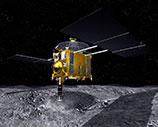Latest News
Topics
January 24, 2012
1st International Announcement of Opportunity for HAYABUSA Sample Investigation
Japan Aerospace Exploration Agency (JAXA) has been engaged in initial analysis of Itokawa’s sample brought back by HAYABUSA. On this occasion we would like to inform you of offering the announcement of opportunity for HAYABUSA Sample Investigation.
Through the peer review, JAXA will provide HAYABUSA sample to researcher who submits research proposal in the framework of this Announce of 0pportunity (herein after referred as "AO"). This AO is planned to be conducted a few times. The 1st International AO issues on January 24th 2012.
- (open new window)Press Release
- (open new window)1St International Announcement of Opportunity for HAYABUSA Sample Investigation: A Brief Introduction
Overview
Outline of HAYABUSA

Asteroids are thought to be celestial bodies that preserve information from the time of the Solar System's formation. If we collect a sample from an asteroid and bring it back to Earth to carry out precise research on it, we can gain some
precious clues to understand the origin and evolution of the Solar System.
Bringing back a sample from a celestial body in the Solar System is called "Sample Return." "HAYABUSA" is a probe to verify the practicality of acquired technology developed to archive future full-scale "sample return missions."
"HAYABUSA' was launched aboard the M-V Launch Vehicle on May 9,2003. It was accelerated by a swing-by of the Earth in May 2004 and reached its target Asteroid Itokawa on September 12,2005, after traveling about 2 billion kilometers. in September and October that year, "HAYABUSA" completed the most remote-sensing and measurement of the geometry of Itokawa and made two landings in November to collect a sample from Itakawa.
Through scientific observations performed during "HAYABUSA's" stay on Itokawa various knowledge was obtained including on its gravity and surface condition. The achievements of "HAYABUSA" were featured in the scientific magazine, "Science."
Overview Asteroid Explorer Information about HAYABUSA
Mission Profile
| Launch Vehicle | M-V-5 |
|---|---|
| Launch Location | Kagoshima Space Center (Uchinoura) |
| Dimensions | Core 1.0m x 1.1m x 1.6m 6.0m full width at deployment of solar paddle |
| Weight | 510kg |
